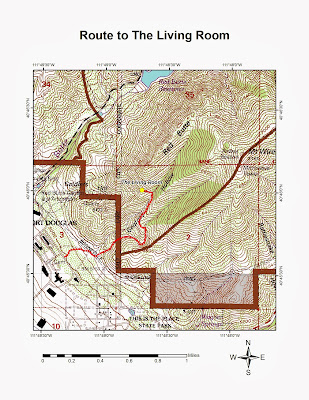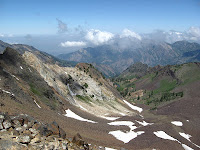Length of day generally refers to the period when the edge of the sun rises from the eastern horizon to when it sets in the western horizon. It can vary greatly throughout the year depending upon the latitude of the hiking/trekking area. The further you get away from the earth's equator, the greater the variation in day length throughout the year. Atmospheric refraction affects the length of day by bending the sun's light, adding a few additional minutes to the beginning and ending of each day-length period. It makes the sun and other astronomical objects appear higher in the sky than they really are, and often distorts and causes a shimmering or rippling effect to these objects (see photo). Once the sun does set and before it rises, a condition known as "civil twilight" exists for a limited period, allowing most outdoor activities to continue under clear atmospheric conditions. Civil twilight is defined as beginning in the morning (civil dawn), and ending in the evening (civil dusk) when the center of the sun is geometrically six degrees below the horizon. More information about twilight can be found at the U.S. Naval Observatory website at:
http://aa.usno.navy.mil/faq/index.php
 |
Distortion of the sun caused
by atmospheric refraction –
Photo credit: www.birdsasart.com |
Determining the length of time it takes to complete a hike or a trek depends largely upon a person's health, strength, and walking pace. One person's travel time may vary much differently than another person's travel time. This is why I don't usually include times to complete a hike or a trek in my posts. Another factor affecting travel time is the type of terrain and/or vegetation a particular route goes through. Level, well-established trails, for example, take a shorter time to travel than areas of bushwhacking, scrambling, and steepness. With regard to determining day length, most sunrise and sunset tables are based off of time zone longitudinal meridians
– particularly
the prime meridian (0
° longitude). Coordinated Universal Time (UTC) is calculated from the prime meridian, and it is recognized as the official reference for time zones throughout the world. Most of the hikes and treks listed in my posts fall into the Mountain Time Zone, which is seven hours earlier (-7) than UTC at 105
° west longitude. The table below, however, identifies the time zone meridians throughout the world in half-hour increments.
While most time zones vary in whole-hour increments from UTC, there are a few (such as the Newfoundland part of Canada, Afghanistan, India, and Iran) that vary in half-hour increments from UTC. Close examination of the table reveals that one hour of time equals fifteen degrees of longitude, or (further divided) one minute of time equals fifteen minutes of longitude. This is important to know when adjusting sunrise and sunset times from a table to the planned travel area. Once the time zone and its meridian have been identified, the difference between it and the travel area longitude can be calculated. Time is added for areas west of the time zone meridian while time is subtracted for areas east of the time zone meridian. For example, a travel area located at 111
° 45' west longitude in the Mountain Time Zone (105
° west longitude) would have a difference of 6
° 45' longitude, or 27 minutes of time. Since the travel area lies further west than the time zone meridian, the 27-minute time difference would be added to the sunrise and sunset times in the table. Another one hour would also be added if the area was observing Daylight Saving Time
– making the total added time 1 hour and 27 minutes. The table below lists the sunrise and sunset times throughout the year for much of the world.
Though the times may vary slightly from year to year (including leap years), it should not be by more than two or three minutes for the next 20 years or so. Sunrise and sunset times can also be adjusted for travel areas between two latitudes. For example, a hike taken during August in a hiking location of 41
° north latitude; the sunrise and sunset times for both 40
° and 45
° north latitude are used in the calculation. The sunrise times for August are 05:13 for 40
° and 05:03 for 45
°, making a difference of 10 minutes. Likewise, the sunset times for August are 18:54 for 40
° and 19:03 for 45
°, making a difference of 9 minutes. Since 41
° is one-fifth of the way between 40
° and 45
°, two minutes (1/5 of 10) are subtracted from the sunrise time for 40
° while approximately two minutes are added to the sunset time for 40
° – resulting in 05:11 and 18:56, respectively, for 41
°. Keep in mind that the times listed in the table above denote monthly averages and can vary depending on the day during the month. Knowing the length of day is an important factor for planning hikes and treks.












































